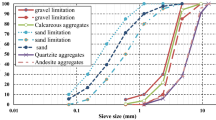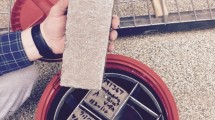Abstract
The behavior of two series of concrete slabs exposed to sulfate-bearing soils was investigated by a numerical model called STADIUM. In addition to the diffusion of ions and moisture, the model also accounts for the effects of dissolution/precipitation reactions on the transport mechanisms. The simulations yielded by the model were compared to the actual degradation of the slabs after 8 years of exposure. The microstructural alterations of concrete resulting from the penetration of magnesium, chloride and sulfate ions were studied by backscatter mode scanning electron microscope observations and energy-dispersive X-ray analyses. The comparison of both series of data indicates that the model can reliably predict the various features of the microstructural alterations of concrete.
Résumé
Le comportement de deux séries de dalles sur sol en béton exposées à des sols chimiquement agressifs a été étudié à l'aide d'un code de calcul numérique appelé STADIUM. Ce modèle permet de décrire le transport couplé de l'eau et des ions dans des matériaux poreux non-saturés en prenant en considération l'influence des réactions chimiques. Les résultats des simultations de la dégradation du béton après huit ans d'exposition à des ions chlore, sulfate et magnésium. Les observations ont été réalisées par microscopie électronique à balayage. Des analyses par dispersion des rayons X ont également été effectuées. Les données démontrent clairement que le modèle perment de prédire avec précision le comportement du béton soumis à différents types d'agression chimique.
Similar content being viewed by others
References
St-John, D. A., Poole, A.W. and Sims, I., ‘Concrete petrography— A handbook of investigative techniques’, (Arnold, London, UK, 1998).
Taylor, H.F.W., ‘Cement chemistry’, (Academic Press Inc., San Diego, USA, 1990).
Ramachandran, V.S., Feldman, R.F., Beaudoin, J.J., ‘Concrete Science’, (Heydon & Sons, London, U.K., 1981).
Skalny, J., Marchand, J., and Odler, I., ‘Sulfate attack of concrete’, (E & FN Spon, London, UK, 2001).
Marchand, J., ‘Modeling the behavior of unsaturated cement systems exposed to aggressive chemical environments’,Mater. Struct. 34 (2001) 195–200.
Marchard, J., Samson, E. and Beaudoin, J.J., ‘Modeling ion transport mechanisms in unsaturated porous media’, Encyclopedia of Surface & Colloid Science, (M. Dekker Publisher, New York, USA, 2002).
Marchand, J., Bentz, D.P., Samson, E. and Maltais, Y., ‘Influence of calcium hydroxide dissolution on the transport properties of hydrated cement systems’, in Materials Science of Concrete Special Volume: Calcium Hydroxide in Concrete, (2001) 113–130.
Maltais, Y., ‘Contribution to the study of ionic transport mechanisms and chemical degradation phenomena of fully or partially saturated cement systems’, Ph.D. Thesis, Dept. of Civil Engineering, Laval University, (in preparation, 2002).
Samson, E., Lemaire, G., Marchand, J. and Beaudoin, J.J., ‘Modeling chemical activity effects in strong Ionic solutions’,Computational Materials Science 15 (1999) 285–294.
Samson, E., Marchand, J., Robert, J. L. and Bournazel, J.P., ‘Modeling the mechanisms of ion diffusion transport in porous media’,International Journal of Numerical Methods in Engineering 46 (1999) 2043–2060.
Pel, L., ‘Moisture transport in porous building materials’, Ph.D. Thesis, Eindhoven University of Technology, The Netherlands, (1995), 125 p.
Zienkiewicz O.C. and Taylor, R.L., ‘The Finite-Element Method’, (4th Edn, McGraw-Hill, USA, 1989).
Novak, G.A. and Colville, A.A., ‘Effloresce mineral assemblages associated with cracked and degraded residential concrete Foundation in Southern California’,Cement and Concrete Research 19 (1989) 1–6.
Diamond, S. and Lee, R.J., ‘Microstructural alterations associated with sulfate attack in permeable concretes’ in Materals Science of Concrete Special Volume: Sulfate Attack Mechanisms, American Ceramic Society, (1999) 123–173.
Jacobsen, S., Marchand, J. and Boisvert, L., ‘Effect of cracking and healing on chloride transport in OPC concrete’,Cement Concrete Research 26 (1996) 869–882.
Diamond, S., ‘Effects of two Danish fly ashes on alkali contents of pore solutions of cement fly ash pastes’,Cement and Concrete Research 11 (1981) 383–390.
Mills, R.H., ‘Mass transfer of water vapor through concrete’,Cement and Concrete Research 15 (1985) 74–82.
Noorany, I. and Stanley, J.F., ‘Settlement of compacted fills caused by wetting’, Proceedings of Settlement’ 94, Geotechnical Engineering Division. American Society for Civil Engineering, (1994) 1516–1530.
Fredlund, D.G. and Rahardjo, H., ‘Soil mechanics for unsaturated soils’, (J. Wiley & Sons, New York, U.S.A., 1993).
Gillott, J.E., ‘Clay in engineering geology’, (Elsevier, Amsterdam, The Netherlands, 1987).
Damidot, D. and Glasser, F.P., ‘Thermodynamic investigation of the CaO−Al2O3−CaSO4−H2O system at 25°C and the influence of Na2O’,Cement and Concrete Research 23 (1993) 221–238.
Damidot, D. and Glasser, F.P., ‘Thermodynamic investigation of the CaO−Al2O3−CaSO4−CaCl2−H2O system and the influence of Na2O’, 10th Congress on the Chemistry of Cement, Gothenburg, Sweden, 1997.
Author information
Authors and Affiliations
Additional information
Editorial Note Laval University (Canada) is a RILEM Titular Member. Prof. J. Marchand was awarded the 2000 Robert L'Hermite Medal. He is Editor in Chief for Concrete Science and Engineering and Associate Editor for Materials and Structures. He participates in RILEM TC 186-ISA ‘Internal Sulfate attack’.
Rights and permissions
About this article
Cite this article
Marchand, J., Samson, E., Maltais, Y. et al. Predicting the performance of concrete structures exposed to chemically aggressive environment—Field validation. Mat. Struct. 35, 623–631 (2002). https://doi.org/10.1007/BF02480355
Issue Date:
DOI: https://doi.org/10.1007/BF02480355




